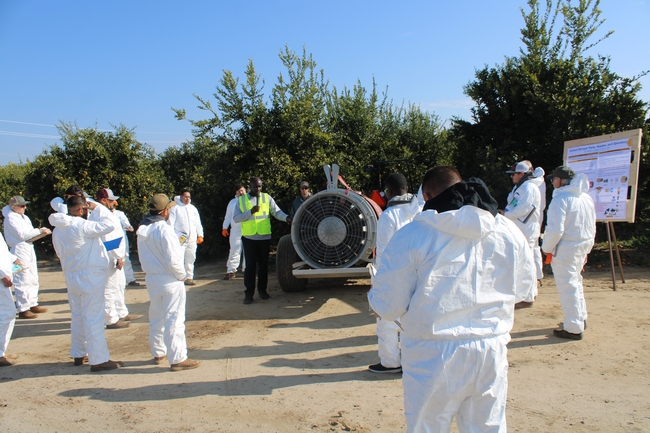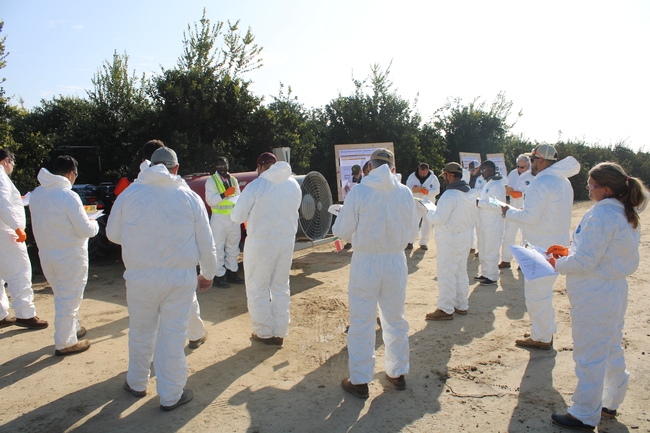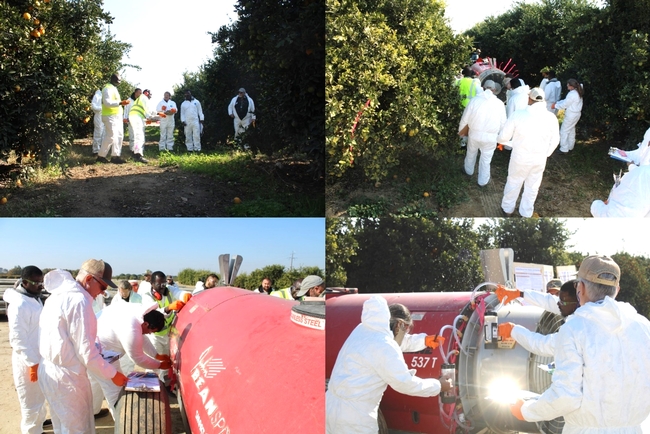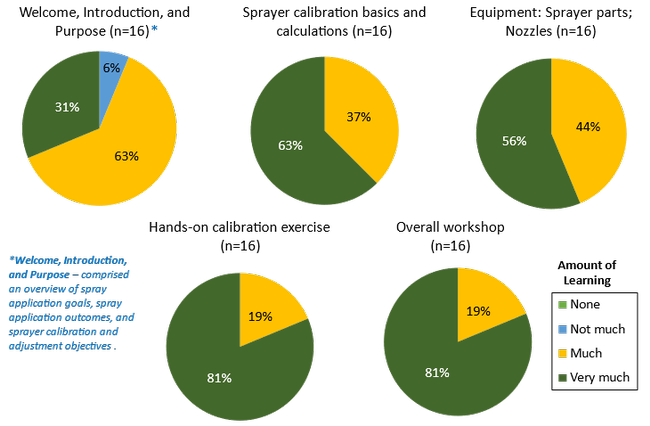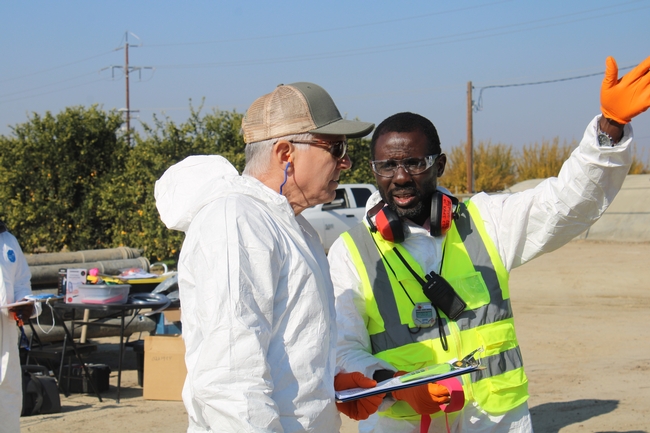UC ANR supports California's crop protection workforce to become more qualified through hands-on Airblast Sprayer Calibration Training. 100% of participants reported learning professional skills that also can improve the sustainability and profitability of California ag.
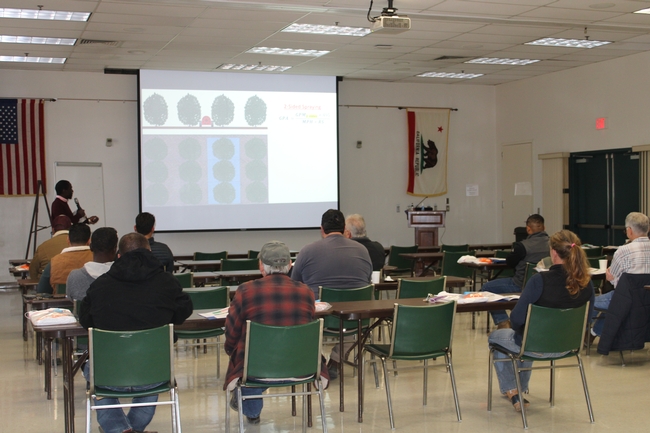
The Issue
As a best practice in pesticide spray application, growers and pesticide applicators should calibrate their sprayers to ensure accurate application rates and compliance with the law as represented by pesticide labels. However, proper understanding of sprayer calibration objectives and steps is needed to avoid a false sense of accuracy using incorrect methods. Educating growers and applicators in calibration methods will therefore empower them to ensure the use of properly calibrated sprayers well-adjusted to the target canopy to minimize pesticide waste and drift loss.
How UC Delivers
A half-day “Airblast Sprayer Calibration Training” was conducted in November 2022 at the Kearney Agricultural Research and Extension (KARE) Center. The in-person extension education event was supported by a California Department of Pesticide Regulation (DPR) grant. It involved classroom and field exercises focused on axial airblast spray applications directed to tree and vine canopies. The training was instructed by Dr. Peter Ako Larbi and assisted by his postdoc scholar Dr. Abiodun Abioye, with logistical support from his Agricultural Application Engineering (AgAppE) Lab and KARE Center personnel. It covered the basic steps and calculations involved in sprayer calibration, with practical follow up via hands-on demonstrations in the field. The DPR approved 3.5 hours of continuing education credits in ‘Other' category for qualifying participants. Sixteen participants were in attendance consisting of growers, applicators/operators, pest control advisors/certified crop advisors, scientists/researchers, and others.
The training started with classroom instruction covering “Welcome, Introduction, and Purpose” (comprising an overview of spray application goals, spray application outcomes, and sprayer calibration and adjustment objectives) and “Sprayer calibration basics and calculations” by Dr. Larbi. It then transitioned to in-field setting in a citrus block in an interactive format allowing participants to interject with questions, comments, and observations. With active participant involvement, the field experience included a presentation on “Sprayer Equipment Parts/Nozzles” by Dr. Abioye, hands-on exercises covering the calibration steps led by Dr. Larbi, a wrap-up discussion and answering of additional questions, and ended by evaluating participant learning. Engaging participants in various hands-on activities corresponding to the recommended calibration steps was intended to reinforce their learning. The spray equipment was operated by KARE Center staff research associate Ryan Puckett.
“Really helped me understand calibration much better.”
“Excellent speakers, demonstrators, trainers.”
The Impact
The participants were fully engaged throughout the training, and all (100%) provided feedback on their learning. Overall, those who reported gaining “much” to “very much” learning are: 94% for “Welcome, Introduction, and Purpose”; 100% for “Sprayer calibration basics and calculations”; 100% for “Equipment: Sprayer parts/Nozzles”; and 100% for “Hands-on calibration exercise”. On average, 97% reported gaining such learning in the classroom portion and 100% in the field. Overall, 100% reported “much” to “very much” learning from the entire training, indicating that it was very effective and provided participants with a great amount of learning. Additional written comments were mostly positive, and many participants verbally expressed their appreciation for the thoroughness of the training.
Dr. Larbi and his AgAppE Program plan to continue providing similar trainings in the future on both ongoing and need bases to arm his clientele with science-based knowledge and skills that will promote their operational efficiency and profitability.
According to the 2021 California Pesticide Use Report, 82,550,620 lbs. of pesticide was used in 941,751 applications for the top five (5) crops in all counties in the San Joaquin Valley covering 45,087,167 acres. Eighty-nine (89) percent of the quantity was applied on 39,742,883 acres of perennial specialty crops, which are the systems of primary focus for Dr. Larbi and his AgAppE program, amounting to 79.38 lbs. per application or 2.34 lbs per acre. Moreover, Dr. Larbi's 2019 Agricultural Application Engineering Program needs assessment revealed that only 22% of growers and applicators calibrated their sprayers 10 or more times a year, 32% calibrated 4-6 times, and 46% calibrated only 1-3 times a year. Hence, assuming a mere 1% of the application done in perennial specialty crop in 2021 was overapplied and another 1% was underapplied due to using uncalibrated sprayers, then 1,467,100 lbs would have been misapplied leading to either reduced pest control or increased pesticide loading on the environment. This number is very significant considering that the situation does not apply to only the top five crops. Thus, by increasing the competency of California's crop protection workforce for properly calibrating sprayers as a best practice, the AgAppE Program potentially increased workforce retention, improved environmental sustainability, and increased the profitability of growers.
